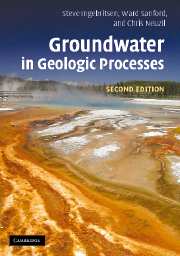Book contents
- Frontmatter
- Contents
- Preface
- Acknowledgements
- List of symbols
- 1 Groundwater flow
- 2 Hydromechanical coupling
- 3 Solute transport
- 4 Heat transport
- 5 Regional-scale flow and transport
- 6 Ore deposits
- 7 Hydrocarbons
- 8 Geothermal processes
- 9 Earthquakes
- 10 Evaporites
- 11 Compaction and diagenesis
- 12 Metamorphism
- 13 Subsea hydrogeology
- References
- Index
12 - Metamorphism
Published online by Cambridge University Press: 12 January 2023
- Frontmatter
- Contents
- Preface
- Acknowledgements
- List of symbols
- 1 Groundwater flow
- 2 Hydromechanical coupling
- 3 Solute transport
- 4 Heat transport
- 5 Regional-scale flow and transport
- 6 Ore deposits
- 7 Hydrocarbons
- 8 Geothermal processes
- 9 Earthquakes
- 10 Evaporites
- 11 Compaction and diagenesis
- 12 Metamorphism
- 13 Subsea hydrogeology
- References
- Index
Summary
In this chapter we discuss the role of groundwater and other fluids in metamorphism. Metamorphism is a broad term that encompasses all adjustments of solid rocks to changes in physical and chemical conditions. It thus includes diagenesis, a more narrowly defined term that is specific to changes undergone by sediments after initial deposition and during and after lithification. We consider diagenesis elsewhere: compaction and associated diagenesis in sedimentary basins is treated in Chapter 11 and the diagenesis of carbonate platforms in Section 13.8. Further, diagenetic processes within accretionary prisms are mentioned in Section 13.7. In this book, then, we use diagenesis to refer to chemical, physical, and biological changes undergone by sediments in a typical sedimentary environment (P generally <100 MPa, T generally <100 ◦C). Though there is no hard and fast distinction between diagenesis and metamorphism, we have reserved the term metamorphism to refer to changes in the solid state at greater pressures and/or temperatures. There is a further distinction between contact metamorphism, which takes place near an igneous intrusion, and the regional metamorphism that occurs in orogenic belts at a wide range of pressures and temperatures. In both types of metamorphism there is generally a gain, loss, and/or exchange of chemical constituents via a fluid phase, a process sometimes termed metasomatism.
We will first discuss the evidence for voluminous fluid fluxes at midcrustal depths and the likely nature of metamorphic porosity and permeability. We then outline a model of crustal-scale hydrology in which the flux of metamorphic fluids is an important element. Finally, we consider specific metamorphic environments: contact metamorphism; regional metamorphism (magmatic arcs and continent–continent collisions); and high-pressure, low-temperature metamorphism (subduction zones).
The understanding of metamorphic processes is a frontier area for hydrogeology. In the words of Rumble (1994), “We face a discrepancy between the growing body of evidence of massive fluid flow and lack of understanding of the physics of flow at middle to lower crustal depths.” Our understanding of the physical dynamics of the magmatic–hydrothermal systems (Section 8.2) associated with contact metamorphism in the mid to upper crust is relatively good, but in the mid- to lower-crustal context of regional metamorphism, as at the mid-ocean ridges (Section 13.4), basic questions about fluid dynamics and the transient nature of permeability remain to be resolved.
- Type
- Chapter
- Information
- Groundwater in Geologic Processes , pp. 385 - 411Publisher: Cambridge University PressPrint publication year: 2006



